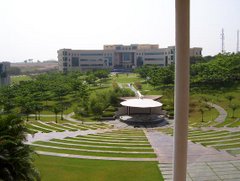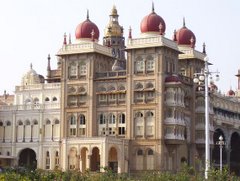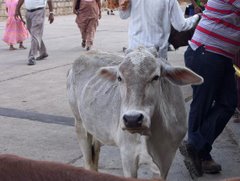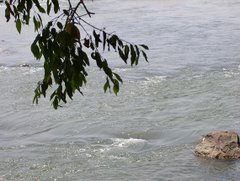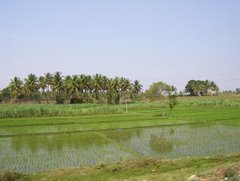 A new species of dinosaur is announced by Indian and American scientists: a 30-foot (9-meter), horned carnivore that hunted other dinosaurs 65 million years ago. A reconstruction of the dinosaur's skull (see photo ) may shed light on how the continents drifted into their present positions and what might have caused the extinction of the dinosaurs.
A new species of dinosaur is announced by Indian and American scientists: a 30-foot (9-meter), horned carnivore that hunted other dinosaurs 65 million years ago. A reconstruction of the dinosaur's skull (see photo ) may shed light on how the continents drifted into their present positions and what might have caused the extinction of the dinosaurs.
When paleontologists Paul Sereno and Jeff Wilson arrived in India in 2001 to study a mixed collection of dinosaur bones gathered by Indian scientists 18 years earlier, they found the bones spread out on an office floor. Sifting through the collection, they separated out the bones of a theropod, or meat-eating dinosaur. When they found the center part of a skull, they recognized a horn resembling those of dinosaurs found in Madagascar. Their search continued, yielding a left hip, then a right hip, then a sacrum. Sereno and Wilson consulted detailed, hand-drawn maps drafted by their Indian counterparts and discovered the bones had been buried next to each other, as if they had been connected.
"There was a Eureka! moment when we realized we had a partial skeleton of an undiscovered species," said Sereno, a paleontology professor at the University of Chicago and a National Geographic Explorer-in-Residence.

65-Million-Year-Old Bones :
The bones were collected in 1983 by Suresh Srivastava of the Geological Survey of India (GSI) and Ashok Sahni, a paleontologist at Punjab University, during a search for dinosaur eggs and nests. Srivastava drew a detailed map to document the position of the fossil bones as they lay in the field. The scientists then stored the 65-million-year-old bones at a GSI office, where they stayed until Sereno and Wilson arrived. Working with Indian experts, Wilson and Sereno reconstructed the skull of the new species, a stocky, 30-foot-long (9-meter-long) carnivore named Rajasaurus narmadensis, which means "regal dinosaur from the Narmada," the river region in western India where the bones were found. The project was supported in part by the National Geographic Society.
"We knew of fragments and bones [in India]," said Sereno, who has discovered new dinosaur species on five continents. "But this skull reconstruction offers the first glimpse into the lost world of the Indian dinosaur."
"We know that there were carnivorous and herbivorous dinosaurs in India through individual bones, but we really don't know just how they looked because no two bones can be reliably said to belong to one individual," said Wilson, who is of the University of Michigan. "Rajasaurus is important because it represents a partial skeleton and preserves many details that clue us into its evolutionary relationships."
The reconstructed skull is missing some parts, but it has the most important pieces: the jaws and the brain case. Between 25 and 30 feet (7.6 and 9 meters) long, the Rajasaurus was heavy and strong, and walked on two legs.
"There are several anatomical details that make Rajasaurus a new species," said Wilson. "Perhaps the most striking is the horn it bears on its head. The horn was probably rather subtle. It may have been low and rounded."

A Carnivorous Family :
The carnivorous Rajasaurus, which lived in the Cretaceous Period at the end of the dinosaur age, preyed on long-necked titanosaur sauropods, herbivorous dinosaurs that also roamed the Narmada region. Bones from both dinosaurs were found together.
Indian paleontologists recently found coprolites (fossilized dung) that provide additional clues to the diet of those titanosaurs.
"Large theropod eggs have also been described by our group from the area where the skeleton of Rajasaurus has been recovered, but it's difficult to relate the theropod eggs specifically to Rajasaurus," said Sahni.
The scientists believe the Rajasaurus is related to a family of large carnivorous dinosaurs, most of which had horns, that roamed the southern hemisphere land masses of present Madagascar, Africa, and South America.
"People don't realize dinosaurs are the only large-bodied animal that lived, evolved, and died at a time when all continents were united," said Sereno.
The Continental Drift :
The Rajasaurus was likely like its contemporary, Tyrannosaurus rex—one of the last species to live before a catastrophe occurred some 65 million years ago. What exactly caused the death of the dinosaurs is a matter of great debate. But the burial site of the bones found in India could provide a clue.
"The sediments in which these dinosaurs were found are closely associated with one of the biggest volcanic activities recorded in the last 500 million years on planet Earth," said Sahni.
As much as a third of India's land mass is covered with lava. That makes it particularly difficult to find dinosaur bones. The task is made even more difficult because India is so heavily populated.
"The best place for a paleontologist to work is an empty desert," said Sereno.
Dinosaur discoveries could also help researchers improve their relatively scant knowledge of how India separated from Africa, Madagascar, Australia, and Antarctica and later impacted Asia to form the Himalaya.
"The details of the timing and route of India's northward migration are not well resolved," said Wilson. "Dinosaurs are good organisms to study the effects of continental drift because they cover continent-scale distances. That is, they seem to record connections between continents fairly well."
The new species will be described in the August issue of the Contributions of the Museum of Paleontology of the University of Michigan. Casts of the dinosaur's skull will be donated by the team to Punjab University and the Geological Survey of India.
Source: The National Geographic channel






